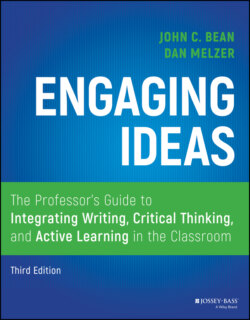Читать книгу Engaging Ideas - John C. Bean - Страница 55
“All About” Writing, or Encyclopedic Order
ОглавлениеWhereas the “and then” paper strings details on a chronological frame, the “all about” paper tries to say a little bit of everything about a topic. When well written, such papers may seem organized hierarchically because the writer usually groups data by category or topics. But the categories do not function as reasons in support of a thesis. Rather, like the headings in an encyclopedia article, they are simply ways of arranging information that do not add up to an argument.
Unfortunately, educators in America have a long tradition of rewarding “all about” writing. Teachers encourage such writing whenever they assign topics rather than problems. Typical topic‐centered examples include assigning a “report on North Dakota” in fifth‐grade social studies, a “library paper on General Rommel” in eleventh‐grade history, or “a term paper on schizophrenia” in college psychology. Assignments like these have endured because they have one major virtue: they increase students' general store of knowledge about North Dakota, General Rommel, or schizophrenia. But they often do little to increase students' maturity as writers and thinkers.
Consider the difference between a student who is asked to write a traditional term paper on, say, Charles Darwin versus a student who is asked to write a research paper on Darwin that must begin with the presentation of a problem or question that the writer will investigate and try to resolve.
Without guidance, the first student will tend toward “all about” writing, perhaps producing an initial outline with headings like these:
1 Early childhood
2 How Darwin became interested in evolution
3 The voyage of the Beagle
4 An explanation of Darwin's theory
5 Darwin's influence
This paper promises to be encyclopedic and devoid of surprise. But when the student is guided toward a focus on a significant question that grows out of the writer's interests and that demands critical thinking, undergraduate research writing can spring to life. Flower (1993, 299) describes a successful undergraduate research project on Darwin written at Carnegie Mellon University for a course in cognitive psychology. Flower's student Kate, a sophomore, posed the following problem about Darwin at the end of her introduction:
In this paper I will look at the creativity of Charles Darwin by asking two questions. Does Darwin's work support or contradict current psychological definitions of creativity? And secondly, what is the best way to account for Darwin's own kind of creativity? Which of the major theories best fits the facts of Darwin's life and work?
Within her paper, Kate presented different theories of creativity and examined Darwin's work in the light of each theory. She proposed that Darwin was indeed creative and that his creativity could best be accounted for by the “problem‐solving theory” of creativity, as opposed to the “romantic imagination theory,” the “Freudian sexual energy theory,” or “Wallis's four‐stage theory.”
Kate's essay reveals how successful undergraduate writing can be when students are actively engaged in posing and exploring questions. Emphasizing inquiry and question asking is thus a promising antidote to “all about” writing.
